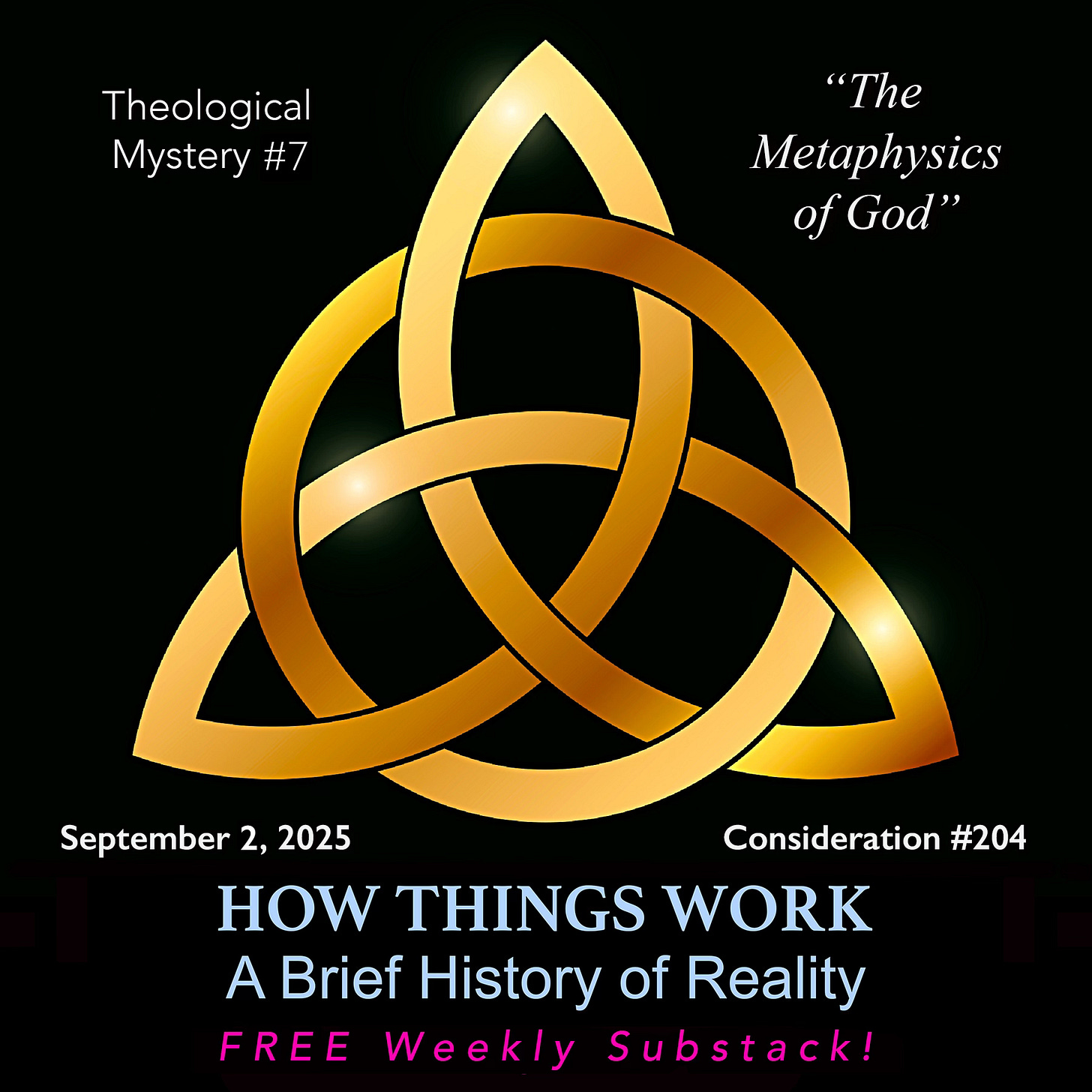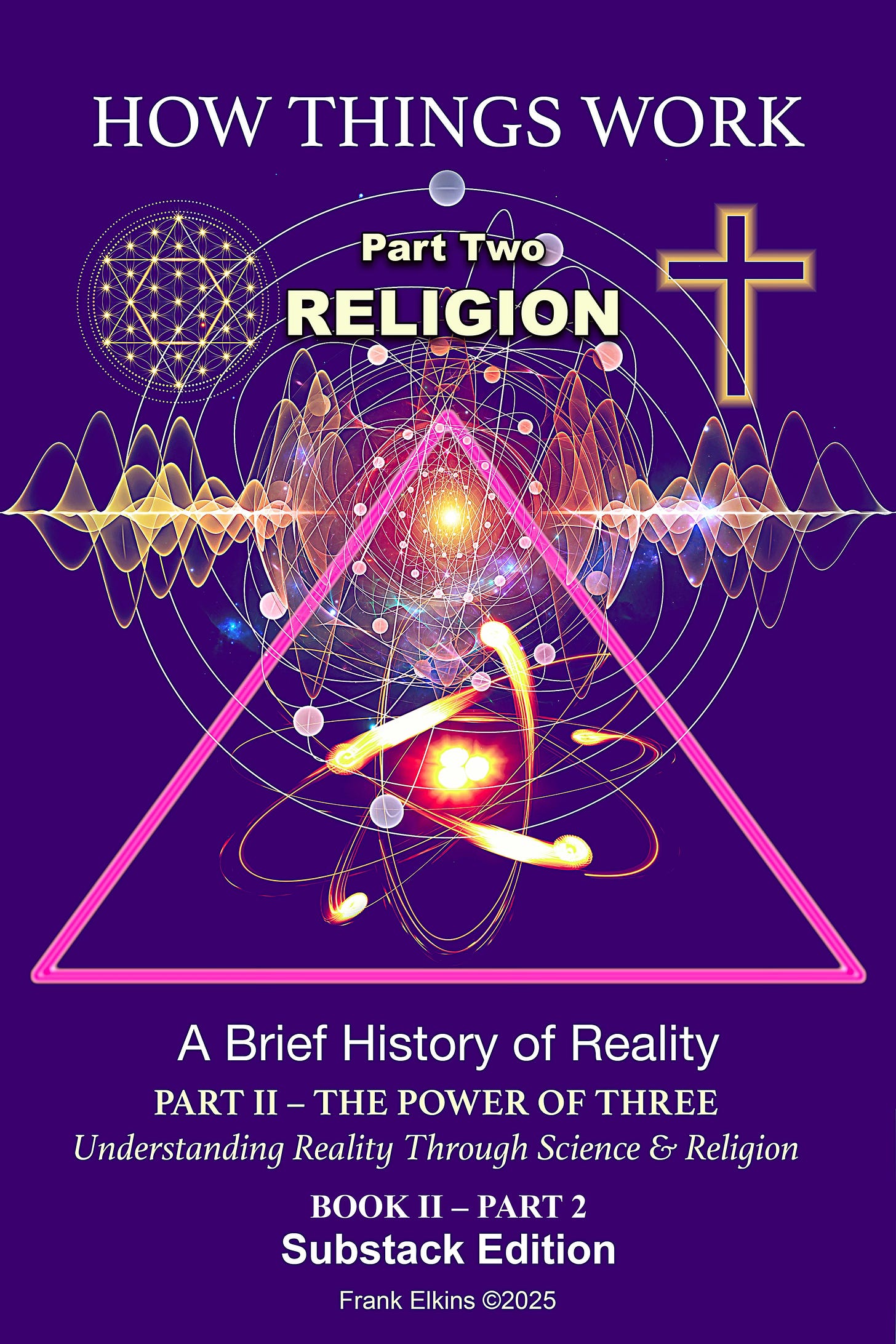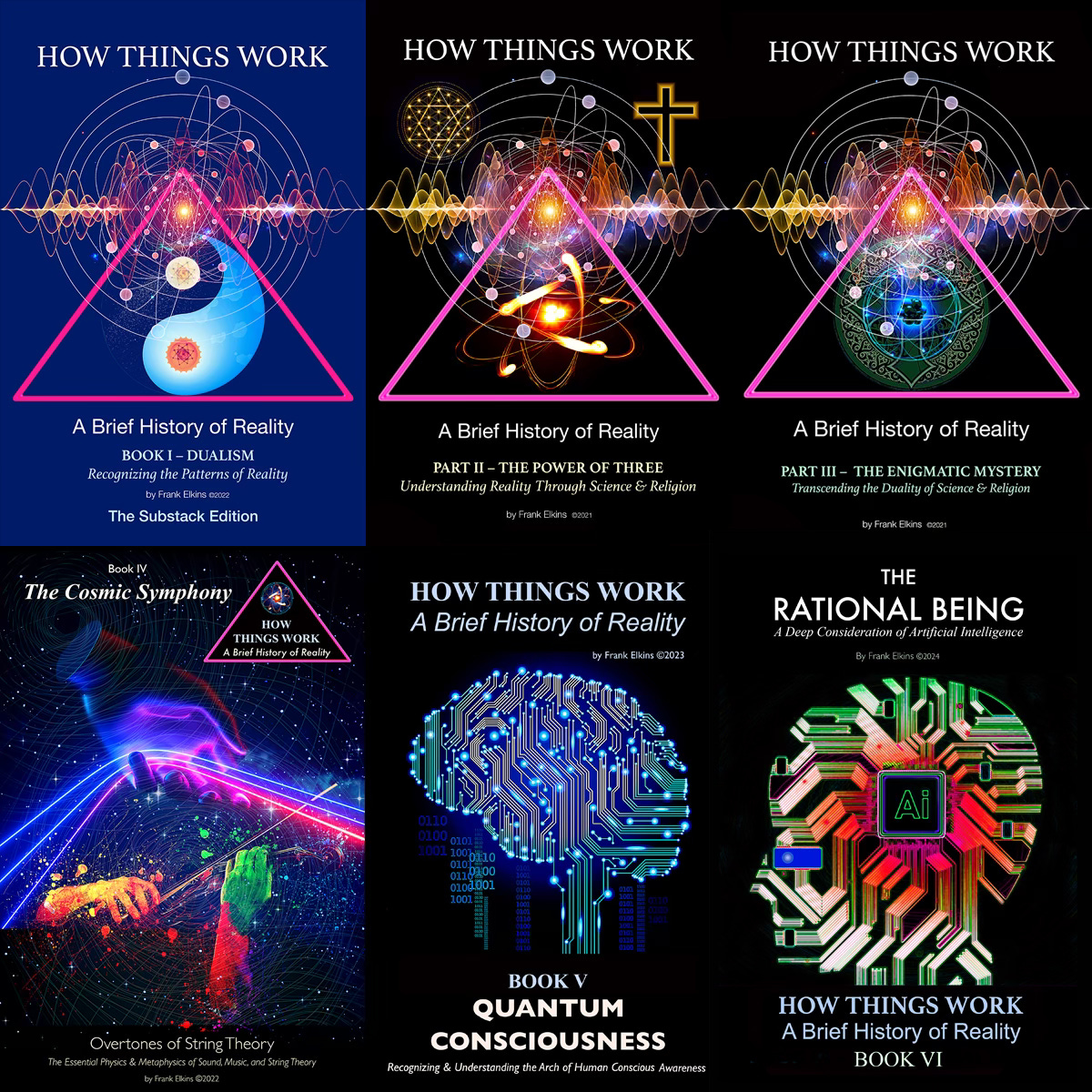Be a part of the Conversation!
Tuesday September 2, 2025
“God, however, lives without the limitations of a three-dimensional universe. He is spirit. And he is infinitely more complex than we are… If we were to use math, it would not be, 1+1+1=3. It would be 1x1x1=1. God is a triune God…Thus the term: ‘Tri’ meaning three, and ‘Unity’ meaning one, Tri + Unity = Trinity.”
– EveryStudent.com
PREFACE
Welcome Everybody!
Imagine you asked someone the following question: “What is the universe?” And imagine they answered: “The universe is everything!” Would that be a satisfactory answer? Well, it depends.
It could be argued that claiming that the universe is everything is both valid and true, because the physical universe is comprised of everything in it. However, in terms of gaining additional information, knowledge, or understanding regarding the universe that answer is basically meaningless. It tells us nothing unique about the universe itself. Now imagine they had answered: “The universe is a physical experience manifested through the laws of space, time, and gravity.” Why is that a better answer?
“…it provides us with unique aspects of the universe…”
First, it gives us additional insight into the structure of the universe. Second, it gives us more insight into the nature of the universe. And third, and perhaps most important, it provides us with unique aspects of the universe that we can further investigate and consider.
When we say that the universe is everything, there is really nowhere else to go from there; that answer does not naturally lead to additional inquiry. However, when we say the universe is a physical experience based on the laws of time, space, and gravity, it encourages other questions such as “What is gravity?” “How does gravity work?” or “How does gravity work with space and time to create the universe?”
“…time, space, and gravity are not analogies for the universe, they are constituents of it…”
So, while answering that the universe is everything may be accurate, and even perhaps enlightening at a certain level, it is not helpful in providing a greater understanding of the universe. However, time, space, and gravity are not analogies for the universe, they are constituents of it, all operating simultaneously in conjunction to manifest what we call the universe. This gives us a new paradigm of consideration that may help us better understand the “big picture” called the universe.
“…we understand that there is one universe and that it manifests itself through time, space, and gravity.”
We are not immediately inclined to object to that answer despite the fact that we asked a question about one thing, the universe, and was then told that the universe was three things. Because we understand that there is one universe and that it manifests itself through time, space, and gravity. We essentially explain what the universe is by demonstrating how it works through the interaction of those three constituents. The more we understand about these three unique aspects of the universe, the more we understand how the “one” universe works.
“Objectively, from a scientific view, the universe exists…”
We generally don’t have a problem with this concept because we assume, and agree, that the universe is “real.” Almost no one disputes that the universe exists. Exactly what it is and how it works may be debated, but its actuality is not. Objectively, from a scientific view, the universe exists; it is self-evident. Both sensory and experimental evidence bear this out.
We can directly observe and interact with the universe not only through the five senses, but also through the science of physics.
CONSIDERATION #204 – The Metaphysics of God
Now, imagine you asked someone this question: “What is God?” And imagine they answered: “God is everything!” Would that be a satisfactory answer? Well, like the first answer regarding the universe it is accurate, yet meaningless. It tells us nothing unique about the nature of God.
Now imagine they had answered: “God is a spiritual experience manifested through the laws of the Father, the Son, and the Holy Spirit. Is that a better answer? It does give us additional insight into the structure of God. It also gives us insight into the nature of God. And it offers us specific aspects of God to investigate and consider. However, although this process follows the same process used to answer the question regarding the universe, it seems somehow less satisfying as an answer for the existence of God. Why?
“…unlike the universe, everyone does not agree that God exists.”
Essentially, it is because unlike the universe, everyone does not agree that God exists. God is not objective, or physical, the way the universe is. We cannot directly observe and do experiments on God; because we cannot directly identify or verify God. God does not exist in the physical world therefore the laws of physics are not applicable to the study of God.
God is a spiritual concept beyond the reason of human beings who are limited by physical perception. Therefore, to understand the metaphysical concept of God, other metaphysical concepts are introduced and used. The Father, Son, and Holy Spirit represent such metaphysical concepts. These metaphysical concepts are not tested through observation and experimentation, but through Biblical reference, Natural Reason, and Divine Revelation. The most significant metaphysical concept in Christianity is The Holy Trinity.
“The term ‘Trinity’ in the Christian context was first recorded around 170 A.C.E”
The word trinity comes from the word trinitas, which is Latin for “three.” The Greek word for trinity is triados. The term “Trinity” in the Christian context was first recorded around 170 A.C.E by Theophilus of Antioch as a way of explaining the nature of the Christian God to a pagan friend using an analogy based on the pagan concept called “the luminaries” consisting of the sun, moon, and stars. He also expresses that God exists to provide light to those in the dark; reconnecting it to John’s original Logos.
“In like manner also the three days which were before the luminaries, are types of the Trinity[Τριάδος], of God, and His Word, and His wisdom. And the fourth is the type of man, who needs light, that so there may be God, the Word, wisdom, man.”
– Theophilus of Antioch to Autolycus
The Roman Catholic dogma related to the Holy Trinity begins in 325 A.C.E with the First council of Nicaea and completed in 381 A.C.E at the First Council of Constantinople. According to the Compendium of the Catechism of the Catholic Church, the official dogma of the Holy Trinity is as follows:
“The Church expresses her trinitarian faith by professing a belief in the oneness of God in whom there are three Persons: Father, Son, and Holy Spirit.
The three divine Persons are only one God because each of them equally possesses the fullness of the one and indivisible divine nature.
They are really distinct from each other by reason of the relations which place them in correspondence to each other.
The Father generates the Son; the Son is generated by the Father; the Holy Spirit proceeds from the Father and the Son.” [CCC 48].
The Holy Trinity plays a critical role in all Christian expression because virtually all sects and denominations baptize people in the name of the Father, the Son, and the Holy Spirit. This is because Jesus directly spoke of this trinity, although he did not refer to it as a trinity. It is not considered to be a logical contradiction, the Mystery of The Holy Trinity is simply beyond the physical perception or understanding of human beings. This mystery cannot be interpreted or proved through natural reason, but only in the Light of Divine Reason through the revelation of Jesus Christ through the Holy Spirit.
The Holy Trinity underlies the source of all the mysteries taught by Jesus and is the gateway to understanding The Kingdom of Heaven.
POSTSCRIPT
Unlike the empirical nature of dualism, trinities reflect rational abstract models of reality holding deep metaphysical truths that can be implemented into the physical, or empirical world. Western reality is defined by these trinities.
The ancient Greeks used this model to develop geometry based on the following trinity: point, line, plane. Once these rational theoretical concepts were accepted as true, we began to understand the nature of the three-dimensional physical world, allowing us to construct empirical objects such as buildings, bridges, and roads. Philosophers used this rational metaphysics to define the reality of the physical and metaphysical worlds.
“…we began to consider our relationship with God in more rational terms.”
The Christian Church developed a rational theology based on the following trinity: Father, Son, and Holy Spirit. Once these rational metaphors were accepted as true, we began to consider our relationship with God in more rational terms. Theologians used this rational metaphysics to define the spiritual relationship between God and human beings, in addition to a new consideration regarding our responsibility as moral beings who possess choice and free will. It defines the reality of empirical and rational actions and consequences in both the physical and spiritual worlds.
Modern science, in addition to Einstein’s trinity of space, time, and gravity, focuses on an atomic trilogy consisting of a proton, neutron, and electron that manifests all physical reality, including the universe itself. Originally believed to be “real” physical particles that were just too small to be perceived, the new quantum world of atoms and subatomic particles appeared to be far less “real” than first thought; generating more scientific questions than scientific answers regarding the nature and reality of the universe.
Quantum Mechanics developed new rational quantum theories based on this quantum trilogy called an atom, which had become more of an abstract quantum concept than a tangible empirical entity. Once these strange and unique theoretical entities were accepted as true, it changed our relationship with the physical universe. Scientists used rational mathematics to develop atomic theories and implement revolutionary new technologies. It redefined our perception regarding the reality of the physical universe.
“…could Artificial Intelligence be the third aspect of a new rational trinity?”
Is it possible that we are on the precipice of understanding a new trinity designed to break the dualism of rationalism and empiricism with a third factor called “Quantum Consciousness?” If successfully implemented, could Artificial Intelligence be the third aspect of a new rational trinity that includes quantum reality? If so, what kind of paradigm shift in reality might result?
“These trinities become the “rational koans” of Western thought…”
In order to break the never-ending cycle of dualism human beings used rational reason to develop metaphysical trinities to move beyond the limitations of dualism. These trinities become the “rational koans” of Western thought; thinking about them does not necessarily directly solve empirical problems, but understanding and utilizing their metaphysical design does generate additional rational possibilities. Trinities are a rational tool used by Western civilization to transcend duality and open the door to a new kind of rationality.
“The Christian Church used the power of three to develop a new rational Christian theology…”
The power of three was the mechanism used to develop Ancient Greek philosophy and metaphysics into a theory of the physical world called geometry based on three rational abstractions: the point, the line, and the plane. Modern science used the power of three as manifested through a proton, neutron, and electron to develop atomic and quantum theories about the reality of the empirical universe. The Christian Church used the power of three to develop a new rational Christian theology designed to reflect the experience of spirituality through three rational, or spiritual, abstractions called the Father, the Son, and the Holy Spirit.
Within all these paradoxes of reality lies a timeless secret based on the metaphysic of three for recognizing, understanding, and experiencing a deeper rationality pointing to an even deeper enigmatic mystery.
Next week we will consider Hegel’s concept of Geist in connection to Artificial Intelligence…
Get More Reality with the “Reality by a Thread” Paid Upgrade!
Click Image to Learn More…
Unique Content Makes Untangling the Knots of Reality “One of the Best Podcasts about History!”
Excerpt from this week’s Podcast: “Untangling Biblical Literary Structure”
“…this unique Substack podcast by FRANK ELKINS is not strictly speaking history. It is a strange mix of history, philosophy, theology, spirituality, physics, and astronomy…Try this podcast for a start.”
– Barbora Jirincova, The Best Podcasts About History
Excerpt from this week’s “Reality by a Thread” (Relationship Between Rational Selves)
“The original Empirical Self represents an empirical manifestation of unity, in that there is only ‘one self’ to consider: the Empirical Self. However, once human beings begin to move beyond the limited identification of the Empirical Self, new Rational Identities, or selves, become incorporated into a kind of ‘hybrid human’ having numerous Empirical and Rational Identities, meaning that the individual has a relationship with several ‘selves’ with which they now identify. This is the beginning of psychological ‘disunity,’ or psychological ‘dualism.’”
– Frank Elkins (Reality by a Thread: September 4, 2025)
All for less than a couple of cafe lattes every month at a local coffee shop! And You Will Have Something Interesting to Talk About With Your Friends at the Coffee Shop!!
Only $7.00 a month or $70.00 a year! UPGRADE NOW!
Now Available!
“RELIGION” (Book II Part 2 – Substack Edition)
A Deep Consideration of the Judeo-Christian Tradition and its Impact and Influence on the reality of Western Civilization...
Discover the spiritual paradigm that defined modern Western Civilization and influenced the world more than any other single factor in recorded history. How did the Judeo-Christian tradition lead to the manifestation of a new worldwide Western religion, foster the Age of Reason, give birth to the United States of America, and establish the academic foundation for modern science?





